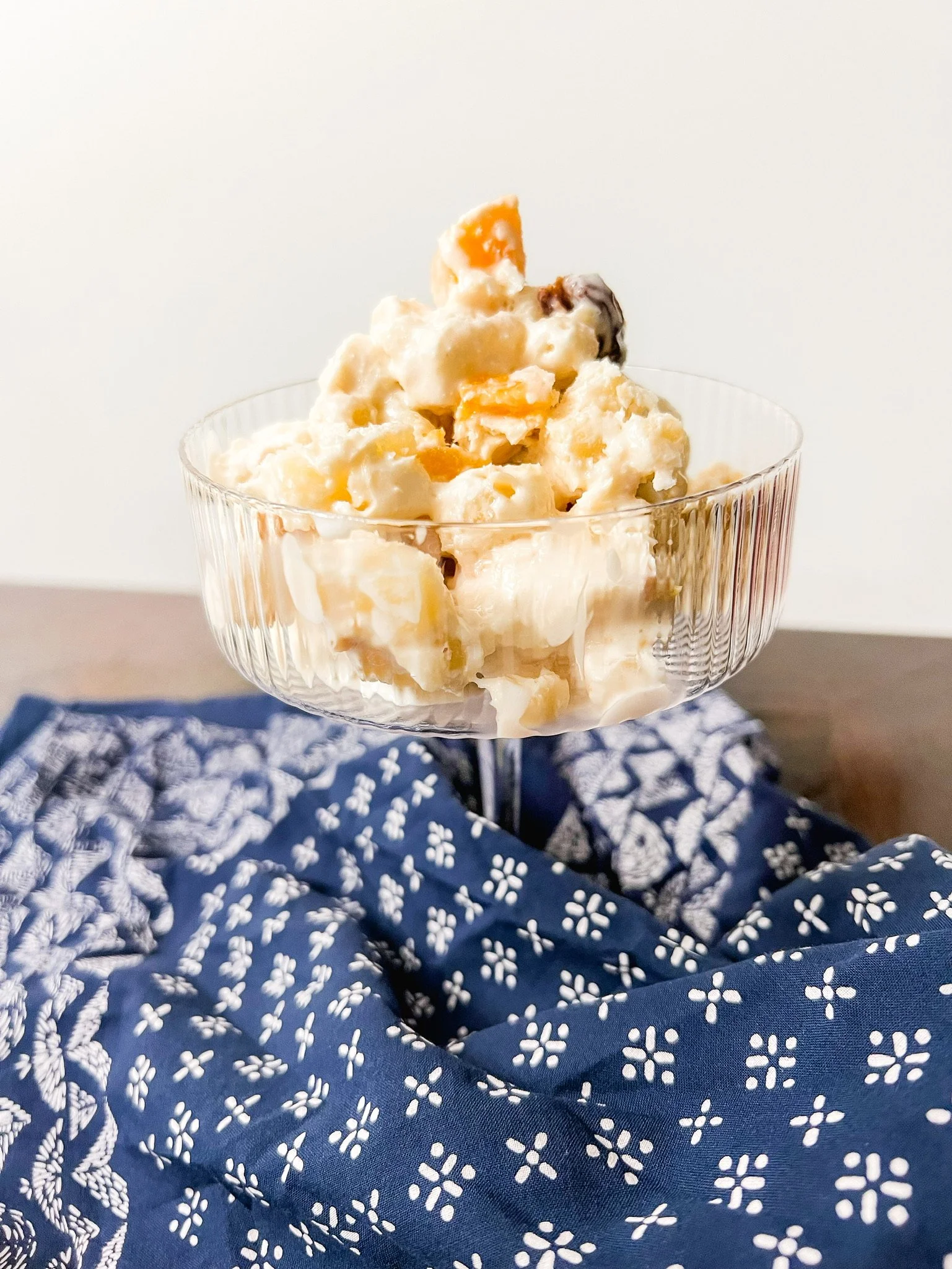Find a recipe.
Filipino Baked Macaroni
FILIPINO BAKED MACARONI
I am not really sure where this dish originated from but it has been part of our Noche Buena celebration for as long as I can remember. It’s only really served and eaten at that time and it’s always a hit. It’s unusual for sure, with Vienna sausage and chicken as the protein and the cheese is Queso de Bola. Our family isn’t even really that big into chicken but there it is, on the table when the Christmas season rolls in. I made it myself for the first time a few years ago when I felt nostalgic for the dishes my family would eat during the holidays and I actually made the whole spread — Tita Lydia’s Baked Ham, this pasta dish, embutido — and one day a few months ago, I wondered why I only made this dish during that time especially now when I knew how to make it. It’s so easy and amazing as it sits in the sauce for a day or two. I think it gets even better.
When I think about this dish and it’s potential origin, there are Filipino recipes out there but none really go into how it came about. My guess would be, much like the Filipino spaghetti, it came over post war through the American occupation and the ingredients were adapted and customized to what was available. Queso de Bola (or Edam cheese) originated from the Netherlands but was also brought in by the Spanish into their colonies. This cheese is mainly consumed during the holidays as well and because this dish was mainly served during the holidays, I can see how that cheese made it into this dish.
When cooking this dish, some things I’ve learned along the way is that poaching the chicken gently keeps it moist and tender. Additionally, slicing and cubing it instead of shredding it is better. Not only from a textural standpoint but it also catches with the sauce in the the little pasta crevices. For the same reason, I love dicing the Vienna sausage as well instead of cutting them into rounds. Also, I love a touch of sweetness in the sauce but unlike other recipes, I don’t add ketchup. Sugar will suffice. The amount I add depends on the tomato sauce so tasting along the way is critical. I prefer the sauce to not be cloyingly sweet. Additionally to add depth, aside from salt and pepper, fish sauce really helps. It gives the dish the appropriate level of umami. Regarding baking, many recipes create a very cheesy version and require a long bake. I think that is good too but it tends to dry out the pasta and doesn’t leave it saucy. I prefer topping the dish with cheese and putting it under the broiler to quickly brown the cheese and then removing it right away so that it gives you a crispy layer on top and leaves a saucy dish under the crispy, cheesy layer.
There are so many good pasta dishes out there so what is so special about this dish? It’s so easy to make with very few ingredients. Many of the ingredients apart from the chicken and the aromatics are probably already in your pantry so this can come together quick. It’s also a dish we tend to make and graze on so if you don’t feel like cooking a whole lot, make this and let people wander in and out of the kitchen as they get hungry. As much as this dish gets better the next day, you will find that it may not last that long.
❤️Tricia
Geri’s Sopas
FILIPINO SOPAS
One of our favorite Filipino spots in Portland is Baon Kainan. It is a food cart in the Concourse Coffee pod together with Matta and No Q No! Taqueria. It is owned by Geri and Ethan Leung, originally Seattle natives who popped up with Matta a few times last year and made a go of it in Portland. In their first year, they won cart of the year which helped establish them and Filipino food in the Portland food scene. Their food is fresh and cart made and you feel the love. When we were thinking of potential contributors for Filipino Food Month, we reached out to Baon Kainan and Geri quickly replied about wanting to share her Sopas recipe. It’s a perfect dish for Portland with our weather that can turn chilly at a drop of a hat.
Sopas is a homestyle Filipino noodle soup generally made with macaroni, vegetables and chicken in a creamy, milky broth often made with stock and milk (in the Philippines, evaporated milk). There are many variations to this dish, predominantly in what protein is used. Aside from chickent, sometimes it’s ground pork, corned beef and hot dogs (or a combination of), that is almost customized by family.
As Geri describes:
“This is one of our favorite Filipino soup recipes. It’s a dish we come back to anytime we need some comfort in a pinch or when we’re feeling under the weather. It’s fast to make, allows the use of leftover ingredients, it’s great the next day and essential when feeling under the weather.”
Some notes and tips from Geri:
Using rotisserie chicken and bouillon may seem like cheating, but there’s no harm in using these ingredients as a fast way to cook a delicious and nutritious meal–great for busy professionals, parents–well, everyone!
If you want to make your own chicken stock–and you have some time–roast chicken bones (or the rotisserie chicken bones) with onions, garlic, and any herbs of your choice for 20 - 30 minutes. Then add the roasted bones and veggies in water and boil for a couple of hours. Strain the broth and discard the bones and veggies.
• You can use whatever milk for this recipe–we used oat milk for this recipe.
• This meal is meant to be easy so versatility is welcome–use whatever veggies or protein you have left over.
• Make this soup vegetarian or even vegan by substituting a plant-based milk and using vegan/vegetarian meat alternatives.
Geri learned how to make Sopas from her mom. This dish was one of her most comforting dishes and she could make it in a pinch without compromising taste. Geri would then make this for Ethan during their dating years so it’s got sentimental value on all counts. Eat it with some steamed rice, it’s comfort food in a bowl.
Macaroni Fruit Salad
MACARONI FRUIT SALAD
“Your food is so weird!”
To many of us, that phrase and phrases similar to it evoke feelings of shame and self-consciousness about being othered. That’s what I got anytime I had to explain what was in my mother’s famous (to my siblings and me) macaroni fruit salad. You read that right, MACARONI FRUIT SALAD. This was the closest thing to stuffing, turkey, or pumpkin pie we had for the holidays. She made it for Noche Buena and New Year every single year.
Before you let your face scrunch up about the concept of a sweet macaroni dish, remember that rice pudding, tapioca pudding, and sweet polenta/grits exist. My mother was a child of the 50s, so not only were canned food and packaged pasta all the rage during that era, the Philippines’ cuisine is heavily influenced by the non-perishables brought to the country by Americans in times they aided us during war and times of attempting to colonize us. The thing that really makes people tell me this dish is weird before trying it is the secret ingredient my mother added, which is a few teaspoons of Best Foods mayonnaise for just a little tartness to round out the sweetness. I don’t know any other Filipino family that makes their macaroni salad this way, but it’s something of an upgrade to an ambrosia, mixed with the flavors of Magnolia Buko Salad Ice Cream.
I am my mother’s daughter, so I realized when it was too late that I didn’t really measure, but this is what’s in this dessert— I don’t add young coconut like she did and add extra pineapple because of my preference:
Macaroni (elbow or Ditalini) - a little less than one package
Nestlé Cream - one can
Condensed milk - about 1.5+ can (to taste)
Canned Fruit Salad - 1-2, drained
Canned Pineapple - 1, drained
Peanuts - coarsely crushed/chopped, about a couple hands full
Seedless Raisins - however much you want
It’s pretty much put everything in a large bowl, mix well, adjust to your liking, and then put in the freezer until ready to serve. Put in the fridge about 6-12 hours before serving (until soft enough to mix and scoop)
Stop telling people their food is weird.
With Love, Nori



